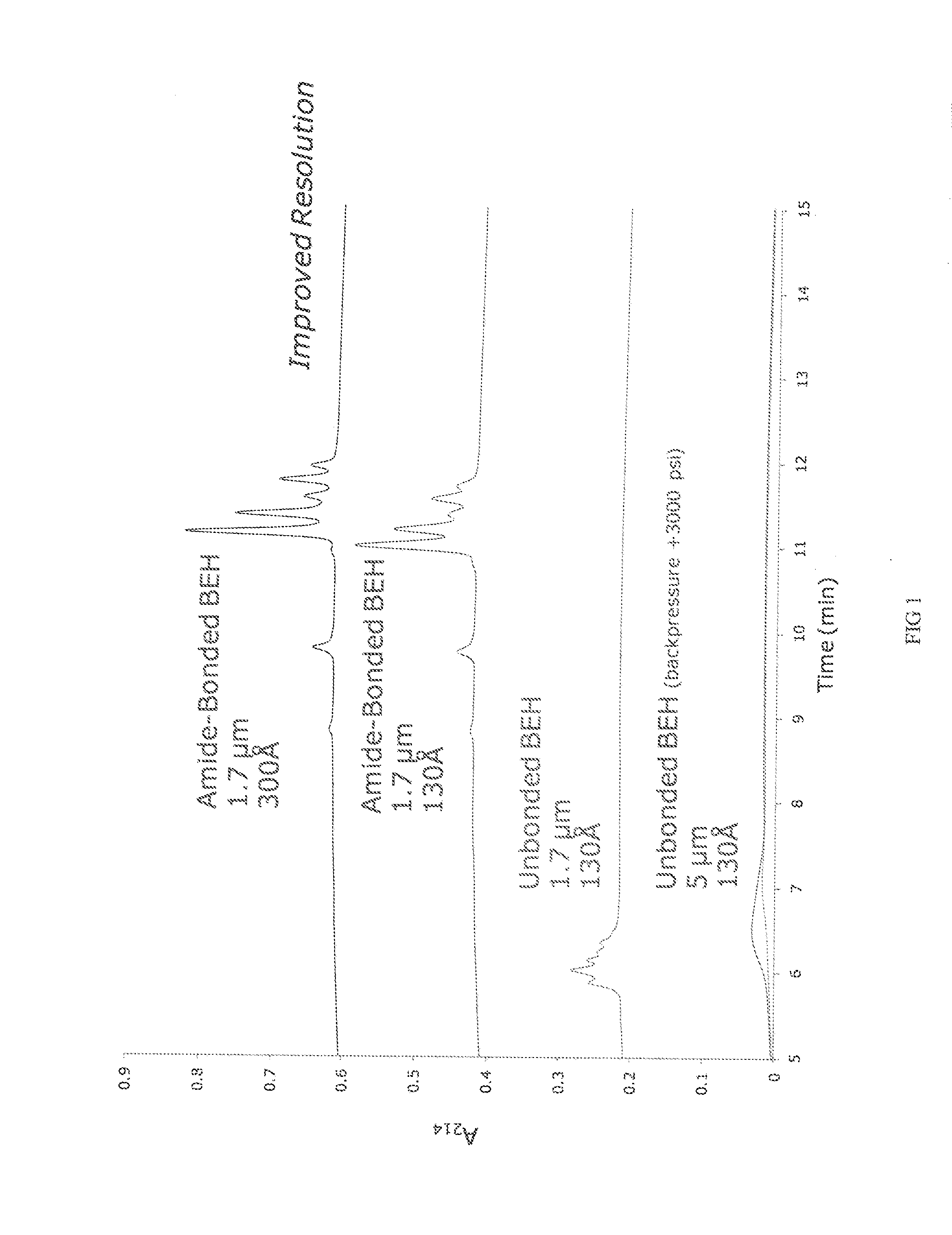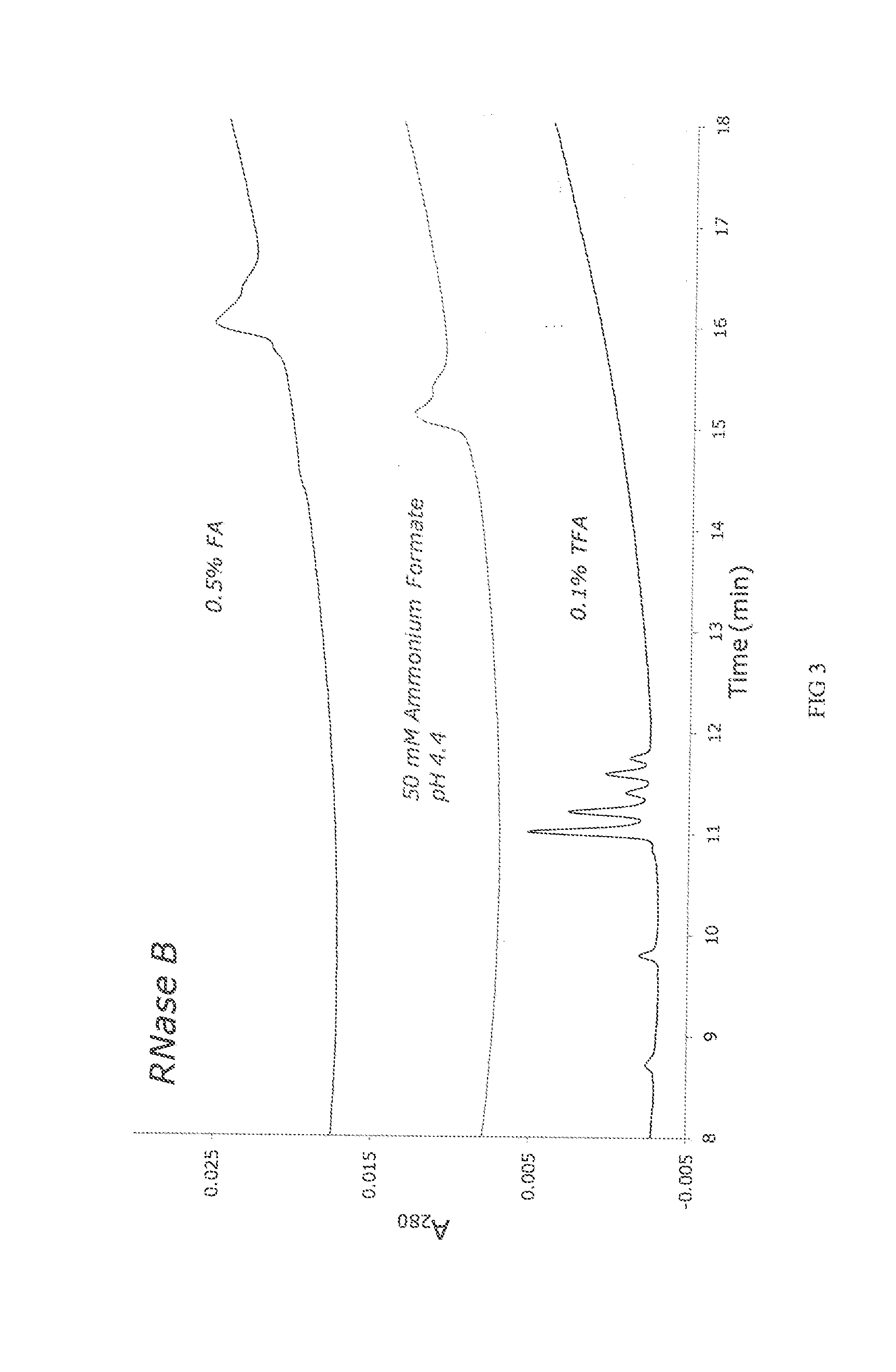Materials for hydrophilic interaction chromatography and processes for preparation and use thereof for analysis of glycoproteins and glycopeptides
a technology of hydrophilic interaction and chromatography, which is applied in the separation process, peptides, component separation, etc., can solve the problems of limited separation of small (20 kda) glycoproteins, a significant challenge, etc., and achieve the desirable retentivity and selectivity of glycans/glycoforms, efficient separation of large biomolecules, and high resolution of large biomolecules
- Summary
- Abstract
- Description
- Claims
- Application Information
AI Technical Summary
Benefits of technology
Problems solved by technology
Method used
Image
Examples
example 1
[0245]Porous ethylene-bridged hybrid particles (60 g, 1.80 μm, SSA=88 m2 / g; SPV=0.66 cm3 / g; APD=300 Å; 6.41% C), prepared following the method described in U.S. Pat. No. 6,686,035, were surface modified using a modified process as detailed in U.S. Pat. No. 4,835,058 A, Example 6, in which 3-methacryloxypropyltrimethoxysilane was replaced with 3-methacryloxypropyltrichlorosilane. In this process the methacryloxypropyl surface modified particles were exposed to an acetone / ammonium acetate solution similar to that detailed in U.S. Pat. No. 6,686,035, example 24. The product of this reaction had 7.65% C.
example 2
[0246]The material of Example 1 was further reacted with acrylamide and potassium persulfate in a methanol solution as detailed in U.S. Pat. No. 4,835,058 A, Example 6. The product is dried in a vacuum oven at 30-50° C. The product of this reaction had 1.12-1.20% N.
example 3
[0247]The process of Example 1 and 2 is modified replacing 3-methacryloxypropyltrichlorosilane with one or more of the following; 3-methacryloxypropylmethyldichlorosilane, 3-methacryloxypropyldimethylchlorosilane, 3-methacryloxypropyltrimethoxysilane, 3-methacryloxypropylmethyldimethoxysilane, 3-methacryloxypropyldimethylmethoxysilane, 3-methacryloxypropyltriethoxysilane, 3-methacryloxypropylmethyldiethoxysilane, 3-methacryloxypropyldimethylethoxysilane, 3-acryloxypropyltrichlorosilane, 3-acryloxypropylmethyldichlorosilane, 3-acryloxypropyldimethylchlorosilane 3-acryloxypropyltrimethoxysilane, 3-acryloxypropylmethyldimethoxysilane, 3-acryloxypropyldimethylmethoxysilane, 3-acryloxypropyltriethoxysilane, 3-acryloxypropylmethyldiethoxysilane, 3-acryloxypropyldimethylethoxysilane, styrylethyltrichlorosilane, styrylethylmethyldichlorosilane, styrylethyldimethylchlorosilane, styrylethyltrimethoxysilane, styrylethylmethyldimethoxysilane, styrylethyldimethylmethoxysilane, styrylethyltrietho...
PUM
 Login to View More
Login to View More Abstract
Description
Claims
Application Information
 Login to View More
Login to View More - R&D
- Intellectual Property
- Life Sciences
- Materials
- Tech Scout
- Unparalleled Data Quality
- Higher Quality Content
- 60% Fewer Hallucinations
Browse by: Latest US Patents, China's latest patents, Technical Efficacy Thesaurus, Application Domain, Technology Topic, Popular Technical Reports.
© 2025 PatSnap. All rights reserved.Legal|Privacy policy|Modern Slavery Act Transparency Statement|Sitemap|About US| Contact US: help@patsnap.com



